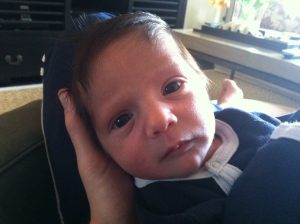18 Apr Raising a Bilingual Child
As I am now a new parent (see pic!), I am ready to put the following research-proven theories to work:
1. Children can learn multiple languages at the same time. The human brain is wired in such a way that a child can learn multiple languages and not realize he is learning them. The learning truly comes “for free” at the earliest stages. And it is never too early to start. (I started the day he was born!) The clearest research on this idea comes from research performed on 6-month-old infants, raised bilingually, who were able to recognize language-relevant sounds better than their monolingual peers.
2. Learning multiple languages does not slow down the primary language. Even though a young bilingual or trilingual child (ages 2-3 especially) may mix her languages together, this is just a temporary “sorting” of the languages that already exist in a clear state in her brain. This temporary confusion of words will sort itself out by age 4-5 if she is exposed to the languages in consistent and authentic ways.
3. The two most important factors are consistency and authenticity. As point 2 above suggests, the most critical factors are consistency and authenticity. In order to raise your child bilingually (or trilingually), he simply needs to hear and see the language from the same people every time he interacts with them. For example, if a caregiver always speaks Spanish to a child (and that caregiver speaks Spanish in an authentic way to him), the child will simply develop the Spanish language in his brain. This development will occur at the same time that, for example, English develops in his brain if that is the language his parents use with him.


